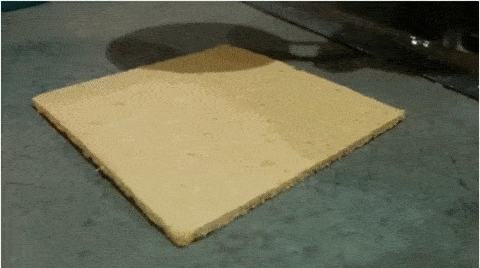Spray antenna: miniature, flexible and powerful
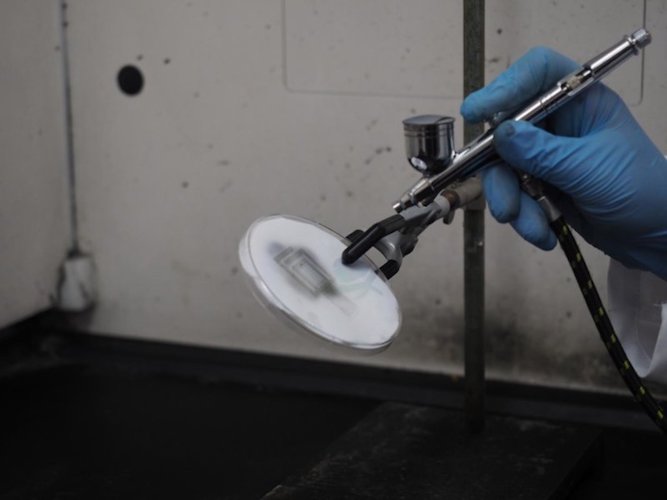
The twenty-first century is filled with many interesting and sometimes incredible inventions. Literally every day something new appears that promises to improve our life with you. One of such innovations is the Internet of things, when various physical objects around us can communicate with each other, forming a certain network. For example, your refrigerator has a list of products that you wanted to buy over the Internet. He can transfer this information to your computer, which will place the order. It sounds extremely unusual, but it is absolutely real. However, a stable connection must be established between the devices, and for this it is necessary to build certain ones into them, in particular, one of such parts may be a radio frequency antenna. Today we’ll talk about a new form of this part, made literally from a spray gun, which is usually painted on walls or cars. What this antenna is made of, what its properties and characteristics are, how it will help the development of the Internet of things - we will look for answers to these and other questions in a report by researchers. Go.
The essence of the study
Researchers immediately turn our attention to how things are with antennas now. Most of them consist of metals (copper, silver, aluminum), which is logical because such substances are excellent conductors, and this is extremely important for the efficient transmission of radio waves. However, there is a factor that limits the capabilities of metal antennas. This is a surface effect that determines the thickness of the material over which an electric current can flow efficiently.

A simplified scheme of the concept of surface effect.
Researchers cite copper as an example. At a frequency of 2.4 GHz (which is usually for Wi-Fi or Bluetooth), the surface effect of copper is 1.33 μm. Silver has 1.29 microns and aluminum has 1.67 microns. Therefore, the thickness of the antennas from these materials must be at least 5 microns in order for them to work effectively.
But when it comes to minimizing devices, such dimensions no longer seem so small, rather the opposite.
Scientists have not forgotten about the existence of a technology for the production of metal fibers, but this method is very laborious and expensive. Therefore, we need a new base for antennas that is radically different from their predecessors, capable of being efficient, fast in production, and, of course, inexpensive. And such a basis can be precisely MXene.
Material for future antenna
Radio frequency antennas are often made of metals, but it is extremely difficult to make a thin, light and flexible antenna from such material. And we remember that now minimizing the size of devices and their details is one of the points of development of any technology. The problem of physical size and shape can be solved by modern nanomaterials such as graphene, carbon nanotubes, and conductive polymers. But such materials have a rather low conductivity, which greatly limits their use.
If you can’t find the perfect material from the available, you can create one yourself. It is in this way that scientists have gone. The basis of the new antennas was two-dimensional titanium carbide (TiC), which in the report also has another designation - MXene * .
MXenes * - or maksens is a class of two-dimensional inorganic compounds.The MXene base was titanium-aluminum carbide (Ti 3 AlC 2 ), from which the Al atomic layer was removed by selective etching * .
Selective etching * is a method of removing one specific component from a substance system.1 gram of Ti 3 AlC 2 powder was gradually added to 10 ml of a solution consisting of 6 ml of hydrochloric acid, 3 ml of 49% hydrofluoric acid and 1 ml of deionized water. The resulting mixture was placed in an ice (cooling) bath for 10 minutes, and then continuously stirred for 24 hours.
After the etching process, the mixture was cleaned 5 times by centrifugation (3500 rpm, 2 minutes each run) until the pH reaches 7-6. Next, the resulting precipitate was added to a cold solution of lithium chloride (20%) and water (80%). Then another 10 minutes in a cooling bath and 4 hours of stirring at room temperature.
That's not all. The next step was a repeated triple cleaning to achieve a dark color, which marks the beginning of the separation process.
So, the base substance is synthesized. Now you need to apply it on a substrate of PET (thermoplastic polyethylene terephthalate) with a thickness of 4 mil (1 mil = 1/1000 ″). PET was used because of its flexibility and transparency.
Before applying MXene to the substrate, it had to be prepared. The substrate was first cleaned by ultrasound in a 5% * Hellmanex III detergent solution for 3 minutes. This was followed by another stage of ultrasonic cleaning (also 3 minutes), but now in deionized water and in ethanol 190 (95% pure undenatured ethanol and 5% H 2 O).
Detergent * - a substance with high surface activity, therefore it is used for cleaning, disinfection or dissolution. The means by which we wash the dishes can be called a detergent.Subsequently, the substrate was dried using compressed air and purified by oxygen plasma for 5 minutes and a flow of O2 of 4 cm 3 / min. This made it possible to remove residual contamination and increase the degree of hydrophilicity * of the surface.
Hydrophilicity * - exaggerated, the ability of the object to absorb water. A bath sponge is a prime example of hydrophilicity. In contrast, there is hydrophobicity when an object repels water, like an umbrella in the rain.As a tool for applying MXene to PET, an ordinary sprayer (spray gun, for those who like more twisted names) has become.
Hydrophilicity as an example of how a dried sponge absorbs water.
Research
results As a result of the manufacturing process described above, a stable aqueous colloidal solution * with Ti 3 C 2 flakes was obtained .
A colloidal solution * - in fact, it is something between a true solution (homogeneous) and a coarse-dispersed solution, when small particles of one of the constituent substances are present in it.
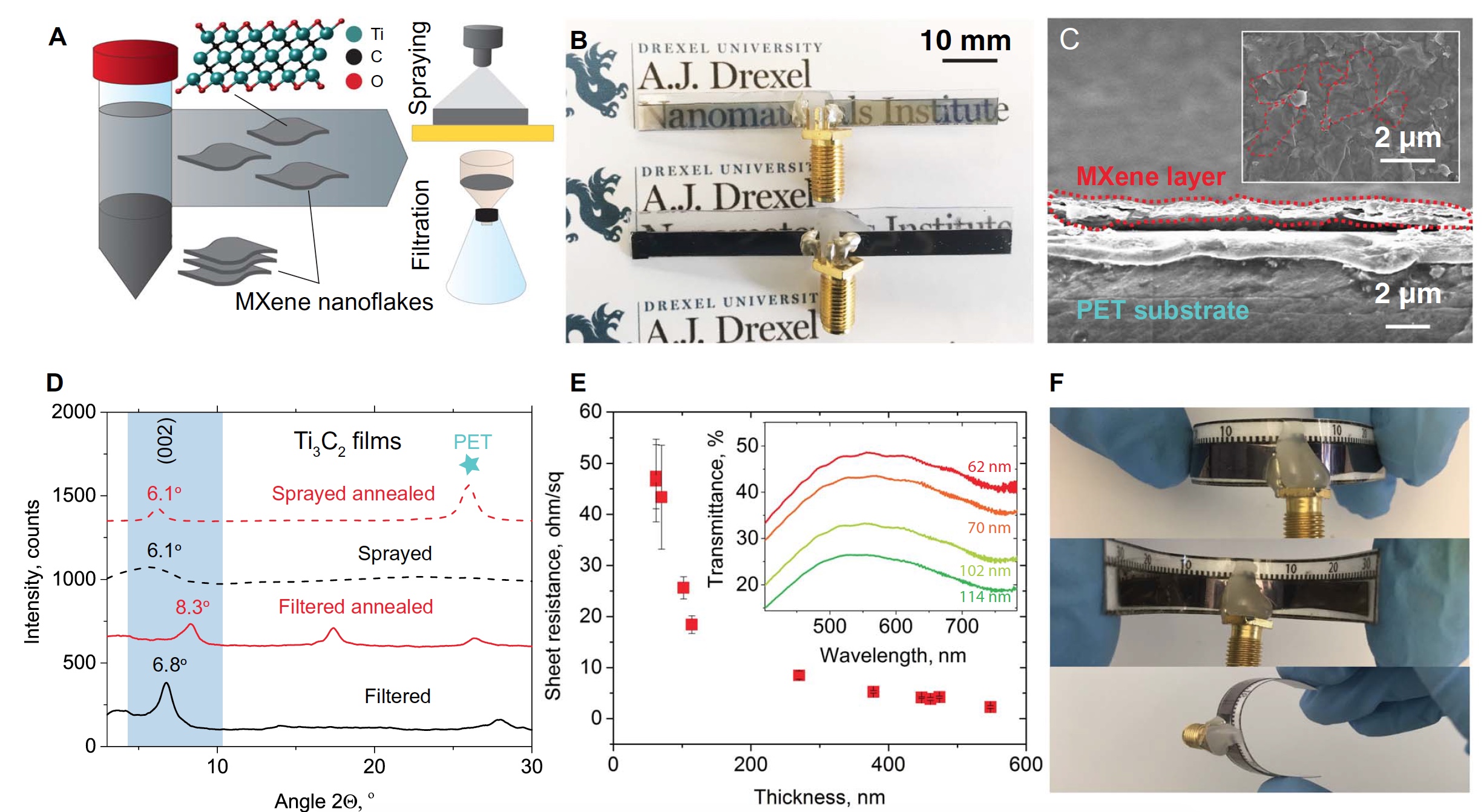
Image No. 1
Image 1a schematically shows the aforementioned Ti 3 C 2 nanoflakes . Also shown are options for applying this substance to a substrate: filtration (filtration) and spraying (spraying). In this study, attention is paid to the second option for creating films that will become the basis of new antennas. The film thickness will be no more than 1.4 microns, if you apply the application by spraying. If you apply filtration - more than 1 micron.
The advantage of spraying is also that a Ti 3 C 2 layer with a thickness of the order of 1 μm can be applied to the rough surface of a PET if the substrate is pretreated with oxygen plasma. Filtration does not give such results when applied to PET.
Image 1b shows images of Hertz dipoles (type of antennas) from MXene with a thickness of 62 nm (sample at the top) and 1.4 μm (sample at the bottom).
1c is a SEM (scanning electron microscope) image where we can see how Ti 3 C 2 flakes (red dashed lines) are distributed over the surface of the substrate (top view), as well as how the MXene layer hides the substrate (side view). 1d
chartthese are the results of X-ray diffraction analysis of samples created in two ways: vacuum filtration and spraying. The black line is the film after vacuum filtration, and the red line is after heat treatment in vacuum at a temperature of 150 ° C. The black dashed line is a 1.4 μm film after spraying, and the red dashed line after additional processing in vacuum at 150 ° C.
In the case of filtration, the vacuum treatment shifted the (002) peak from 6.8 ° to 8.3 °. And in the case of spraying - from ~ 5 ° to 6.1 °.
An extremely important indicator of a substance in the context of radio frequency circuits is the resistance of the film surface. On chart 1ewe can see different resistance indices at different film thicknesses obtained by four-point resistance measurements. When the film thickness was 1.4 μm, the resistance reached 0.77 ± 0.08 ohms per square. If the film was 62 nm thick, the result was 47 ± 8 ohms per square, and the transmittance of light at a wavelength of 550 nm was 49%.
An important observation of this analysis is the fact that the resistance increases upon reaching a thickness of ≤100 nm. This, according to the researchers, is most likely due to the discontinuity of bonds between individual Ti 3 C 2 nanoflakes , which is due to the inaccuracy of manual spraying.
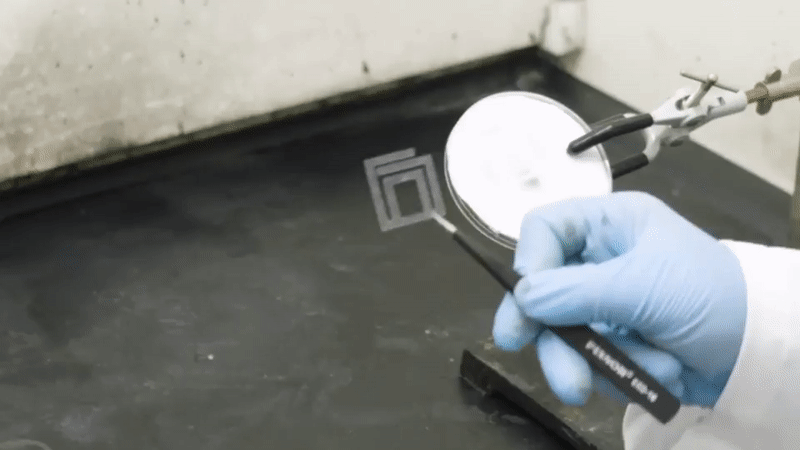
Sample after spraying procedure.
Researchers, and with them we, have already studied the properties of the material. The next step is to check the operability of devices created on the basis of the material manufactured by MXene.
3 devices were made to test certain parameters:
- Hertz dipole for checking radiation properties;
- transmission line for checking wave propagation;
- An RFID tag (radio frequency identification) for studying backscattering when a wave is reflected back to the source.

Image No. 2
Half-wave dipole antennas are extremely common in various fields (broadcasting, mobile phones, wireless connections, etc.) because they propagate waves in all directions. Therefore, this type of antenna was chosen to test the wave characteristics.
Figure 2a shows a diagram of such an antenna made from the tested MXene with a frequency of 2.4 GHz. The total length of the dipole is 62 nm, which is half the wavelength at this operating frequency. The main indicators that were analyzed were the return loss and radiation characteristics.
The return loss rates vary depending on the thickness: from −12 decibels at 114 nm to −65 decibels at 8 μm. It is clearly seen that the return loss increases with thickening of the antenna. Researchers point to the relationship between this trend and the correlation of thickness and surface resistance, as discussed earlier. It is also noted that the return loss can directly depend on changes in resistance due to different lengths, which decrease with antenna thinning. This, again, is due to the manual method of spraying MXene onto a substrate.
2b are measurements of the reflection coefficient (S 11 ) of a dipole antenna of various thicknesses (from 114 nm to 8 μm). Measurements of the standing wave coefficient, showing how efficiently the power is transmitted to the antenna and the impedance matching, are shown in the graph2c . Black squares are the tested MXene, red circles are copper, and blue rhombuses are aluminum.
The radiation directivity of the dipole antenna was measured in a special anechoic chamber, and the Vivaldi antenna acted as a signal receiver. A view of the test room is shown in image 2d .
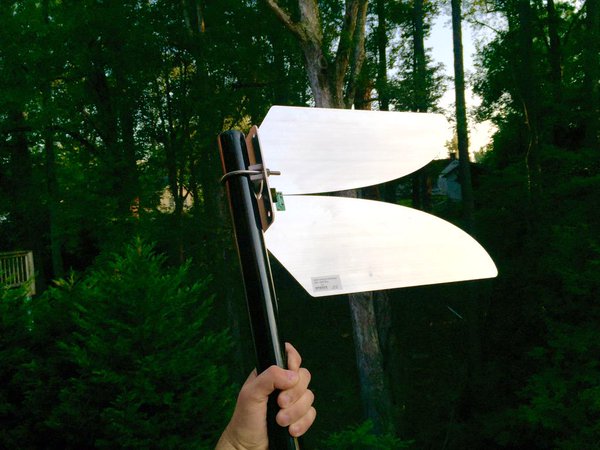
An example of a Vivaldi antenna.
In the adjacent graph ( 2e ), we already see the radiation pattern of the MXene antenna with a thickness of 8 μm. Finally, a 2f plot showing the maximum directivity of the MXene antenna.
Researchers note a very important characteristic of the new antenna, its reflection coefficient. This indicator was -65 dB for an antenna with a thickness of 8 μm, which is much better than that of antennas from other nanomaterials of corresponding thickness.
Even with a thickness of 1.4 μm, the resulting coefficient (-36 dB) is better than for antennas of 7 μm made of printed graphene, laminated graphene or silver ink.
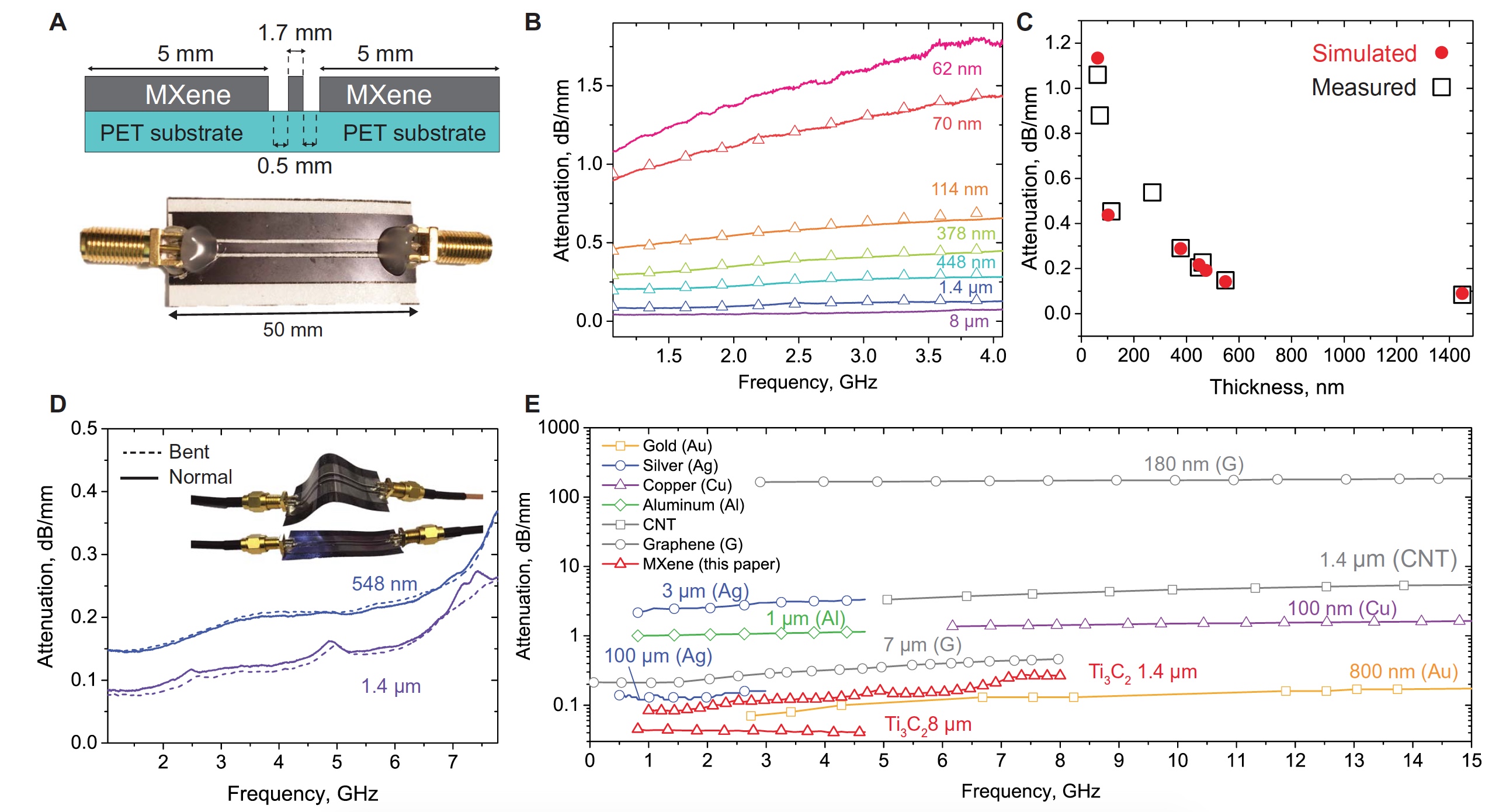
Image No. 3
So, now we proceed to test the second device from the tested material, to the transmission line. This is a very important, one might say, the main component of various RF devices. They are needed to transmit radio frequency signals from point A to point B with minimal energy loss.
Out of the whole variety of types of transmission lines for testing, one was chosen - a strip waveguide. In such a waveguide, electromagnetic waves propagate along two or more conductors located in the same plane. The layout and appearance of the waveguide is shown in image 3a . The signal is transmitted along the central conductor (1.7 μm wide), and two on the sides of it at a distance of 0.5 μm are ground.
The test was carried out by waveguides with a thickness of 62 nm to 8 μm, as well as the previous test subjects — dipole antennas. With decreasing thickness, the attenuation coefficient increased, as can be seen in graph 3b . But graph 3c shows that the measured data almost completely coincides with those calculated in advance.
The flexibility of such a waveguide ( 3d ) was also tested . Changing the shape of the waveguide did not lead to any changes in its characteristics, which makes MXene an excellent material for flexible, compact devices. However, with constant bending, an increase in surface resistance by 14% is observed, which can be solved by applying the centrifugation method to deposit Ti 3 C 2 on the substrate, which will allow more uniform distribution of nanoflakes on the surface.
Further, the researchers compared the attenuation coefficients of their creation with those that were created earlier. Thus, at 1 GHz, the MXene attenuation coefficient (1.4 μm) is 50 times less than that of a 7.7 μm thick graphene waveguide, and 300 times less than that of a silver ink waveguide. Details of the comparison can be seen in graph 3e .
And in conclusion, the third MXene-based device, the RFID tag, was tested.

Image No. 4
Figure 4a shows the scheme and principle of operation of the RFID antenna. Graph 4b shows the downlink reading distances of three different RFID antennas. All three samples show a reading range of 6 m. When the maximum matching of the input impedance of the RFID chip is achieved, the range expands to 8 m.
The above indicators are extremely encouraging, but Ti 3 C 2 has an important drawback - oxidation. Ti 3 C 2 nanometer flakes are absolutely stable only in an inert atmosphere. Argon (Ar) was used in this study. If the film enters an oxygen-containing medium, it begins to slowly collapse. Measurements showed that within 70 hours Ti 3 C 2retains its properties in ordinary air. This applies to individual flakes, individual. If there are many of them, and they form groups, then such a set of nanoflakes can exist without negative changes in the air for up to 30 days. This is due to their accuracy, since they are tightly adjacent to each other and protect the inner part from oxidation, thereby lengthening their service life.
According to scientists, at the moment it is possible to solve the problem of oxidation by laminating parts based on Ti 3 C 2 or by placing them inside sealed devices.
Details of calculations, tests and measurements are available in the report of scientists and in additional materials to it.
Epilogue
The above material fully deserves special attention, given its characteristics, according to tests and tests. Lightness, flexibility, small size and at the same time good performance are the factors that can attract many companies in the future. The devices around us are getting smarter, some of them are getting smaller. Changing the size of something, you expect a deterioration in its characteristics. That is why many research groups are working on creating new devices, new parts, searching for new materials or on their synthesis. All so that the productivity of future technologies does not depend on their physical characteristics or the environment of their use.
In addition, “aerial from a sprayer” - the phrase itself sounds as futuristic as Isaac Asimov could have imagined. But modern scientists will not be surprised. Rather, on the contrary, it is they who do not cease to amaze us, and we do not cease to be surprised and rejoice at their discoveries, for the majority are aimed at the common good.
Thank you for staying with us. Do you like our articles? Want to see more interesting materials? Support us by placing an order or recommending it to your friends, a 30% discount for Habr users on a unique analogue of entry-level servers that we invented for you: The whole truth about VPS (KVM) E5-2650 v4 (6 Cores) 10GB DDR4 240GB SSD 1Gbps from $ 20 or how to divide the server? (options are available with RAID1 and RAID10, up to 24 cores and up to 40GB DDR4).
VPS (KVM) E5-2650 v4 (6 Cores) 10GB DDR4 240GB SSD 1Gbps until December for free when paying for a period of six months, you can order here .
Dell R730xd 2 times cheaper? Only we have 2 x Intel Dodeca-Core Xeon E5-2650v4 128GB DDR4 6x480GB SSD 1Gbps 100 TV from $ 249 in the Netherlands and the USA! Read about How to Build Infrastructure Bldg. class c using Dell R730xd E5-2650 v4 servers costing 9,000 euros for a penny?

